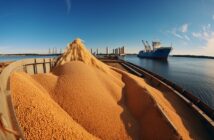Defra has clarified its position about the rules for ammonia mitigation with urea fertilisers, which means that as originally planned, farmers must use inhibitors (or other permitted forms of mitigation) after April 1st 2024.
The government agreed with the NFU and industry partners that a farming industry self-regulation approach will work best for the environment and food production. These guidelines will be applied through the Red Tractor Assurance Standard. If farmers do not support this voluntary option and deliver the required reductions in emissions, Defra will revert to regulation.
OMEX Agriculture launched its own urease inhibitor in November 2022, in anticipation of the Defra ruling and to help farmers grow crops more sustainably. NitroShield can reduce ammonia emissions from urea containing fertilisers by more than 70%, as well as lift winter wheat yields by 0.3t/ha and grain protein by 0.2%.
David Booty, OMEX head of technical, said: “We wanted to be in a position where we had a tried and tested product alongside solid research and advice to offer farmers before the guidance became official. Adding NitroShield to liquid nitrogen applications can help farmers meet this requirement, whilst improving efficiency, and at the most effective application rates. With less ammonia lost to the atmosphere and contained within the soil, the nitrogen applied alongside this innovative urease inhibitor is better utilised by crops.
“NitroShield gives reliable reductions of over 70% in ammonia emissions when mixed with Nitroflo or Nitroflo S grades prior to application,” he says. “The choice of whether to add it or not should be made on farm, on the day according to the date of application, the soil and weather conditions and any other mitigation factors, such as if fertiliser is incorporated within 24 hours.”
Mr Booty recommends that NitroShield should be routinely used for all nitrogen applications after 31st March unless signed off as unnecessary by a FACTS qualified adviser.




